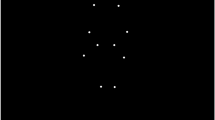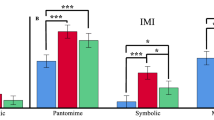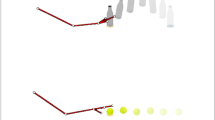Abstract
This paper examines upper-body movement kinematics in individuals with high-functioning autism (HFA) and Asperger’s disorder (AD). In general, the results indicate that HFA is more consistently associated with impaired motoric preparation/initiation than AD. The data further suggest that this quantitative difference in motor impairment is not necessarily underpinned by greater executive dysfunction vulnerability in autism relative to AD. Quantitative motoric dissociation between autism and AD may have down-stream effects on later stages of movement resulting in qualitative differences between these disorder groups, e.g. “motor clumsiness” in AD versus “abnormal posturing” in autism. It will be important for future research to map the developmental trajectory of motor abnormalities in these disorder groups.

Similar content being viewed by others
Notes
We acknowledge that Reaction Time is not a pure measure of ‘motor preparation’ as the involvement of attentional deployment and other cognitive factors can not easily be extracted from this measure. Notwithstanding, the separation of the early and late stage components of this kinematics task is a very close approximate to the preparation and execution aspects of movement.
References
Achenbach, T. M. (1991). Manual for the child behavior checklist, 4–18 and 1991 profile. Burlington: University of Vermont, Department of Psychiatry.
American Psychiatric Association (1994). Diagnostic and statistical manual of mental disorders (4th ed.). Washington, DC: American Psychiatric Association Press.
American Psychiatric Association (2000). Diagnostic and statistical manual of mental disorders (4th ed.) -TR. Washington, DC: American Psychiatric Association Press.
Bellgrove, M. A., Phillips, J. G., Bradshaw, J. L., Hall, K. A., Presnell, I., & Hecht, H. (1997). Response programming in demential of the Alzheimer type: A kinematic analysis. Neuropsychologica, 35, 229–240.
Berkeley, S. L., Zittel, L. L., Pitney, L.V., & Nichols, S. E. (2001). Locomotor and object control skills of children diagnosed with autism. Adapted Physical Activity Quarterly, 18, 405–416.
Beversdorf, D. Q., Anderson, J. M., Manning, S. E., Anderson, S. L., Nordgren, R. E., & Felopulos, G. J. (2001). Brief report: macrographia in high-functioning adults with autism spectrum disorder. Journal of Autism and Developmental Disorders, 31, 97–101.
Bradshaw, J. L. (2001). Developmental disorders of the fronto-striatal system: Neuropsychological, Neuropsychiatric and Evolutionary perspectives. Hove, East Sussex: Psychology Press Ltd.
Brasic, J. R., & Barnett J. Y. (1997). Hyperkinesias in a prepubertal boy with autistic disorder treated with haloperidol and valproic acid. Psychological Reports, 80, 163–170.
Chugani, D. C., Muzik, O., Rothermel, R. D., Behen, M. E., Chakroaborty, P. K., & Manger, T. J. (1997). Altered serotonin synthesis in the dentato-thalamo-cortical pathway in autistic boys. Annals of neurology, 41, 666–669.
Courchesne, E. (1999). An MRI study of autism: The cerebellum revisited. Neurology, 52, 1106–1107.
Courchesne, E., Hesselink, J. R., Jernigan, T. L., & Yeung-courchesne, R. (1987). Abnormal neuroanatomy in a non-retarded person with autism. Archives of Neurology, 44, 335–341.
Courchesne, E., Karns, C. M., Davis, H. R., Ziccardi, R., Carper, R. A., & Tigue, Z. D. (2001). Unusual brain growth patterns in early life in patients with autistic disorder: An MRI study. Neurology, 57, 245–254.
Courchesne, E., Kilman, B. A., Galambos, R., & Lincoln, A. J. (1984). Autism: Processing of novel auditory information assessed by event-related brain potentials. Electroencephalography and Clinical Neurophysiology: Evoked Potentials, 59, 238–248.
Courchesne, E., Muller, R. A., & Saitoh, O. (1999). Brain weight in autism: Normal in the majority of cases, megalencephalic in rare cases. Neurology, 52, 1057–1059.
Courchesne, E., Townsend, J., Akshoomoff, N. A., Saitoh, O., Yeung-Courchesne, R., & Lincoln, A. J. (1994a). Impairment in shifting attention in autistic and cerebellar patients. Behavioral Neuroscience, 108, 848–865.
Courchesne, E., Townsend, J. P., Akshoomoff, N. A., Yeung-Courchesne, R., Press, G. A., & Murakami, J. W. (1994b). A new finding: Impairment in shifting attention in autistic and cerebellar patients. In: S. H. Broman, & J. Grafman (Eds.), Atypical cognitive deficits in developmental disorders: Implications for brain development (pp. 101–137). Hillsdale, NJ: Erlbaum.
Courchesne, E., Yeung-courchesne, R., Press, G. A., Hesse-Link, J. R., & Jernigan, T. L. (1988). Hypoplasia of cerebellar vermal lobules VI and VII in autism. New England Journal of Medicine, 318, 1349–1354.
Damasio, A. R., & Maurer, R. G. (1978). A neurological model for childhood autism. Archives of Neurology, 35, 777–786.
Fernell, E., Watanabe, Y., Adolfsson, I., Tani, Y., Bergstrom, M., & Hartvig, P. (1997). Possible effects of tetrahydro-biopterin treatment in six children with autism—clinical and positron emission tomography data: A pilot study. Developmental Medicine and Child Neurology, 39, 313–318.
Georgiou, N., Bradshaw, J. L., Iansek, R., Phillips, J. G., Mattingley, J. B., & Bradshaw, J. A. (1994). Reduction in external cues and movement sequencing in Parkinson’s disease. Journal of Neurology, Neurosurgery, and Psychiatry, 57, 368–370.
Georgiou, N., Iansek, R., Bradshaw, J. L., Phillips, J. G., Mattingley, J. B., & Bradshaw, J. A. (1993). An evaluation of the role of internal cues in the pathogenesis of Parkinsonian hypokinesia. Brain, 116, 1575–1587.
Ghaziuddin, M., & Butler, E. (1998). Clumsiness in autism and Asperger syndrome: A further report. Journal of Intellectual Disability Research, 42, 43–48.
Ghaziuddin, M., Butler, E., Tsai, L., & Ghaziuddin N. (1994). Is clumsiness a marker for Asperger syndrome? Journal of Intellectual Disability Research, 38, 519–527.
Ghaziuddin, M., Tsai, L. Y., & Ghaziuddin, N. (1992). Brief report: A reappraisal of clumsiness as a diagnostic feature of Asperger syndrome. Journal of Autism and Developmental Disorders, 22, 651–656.
Gillberg, C. (1989). Asperger syndrome in 23 Swedish children. Developmental Medicine and Child Neurology, 31, 520–531.
Hallet, M., Lebiedowska, M. K., Thomas, S. L., Stanhope, S. J., Denckla, M. B., & Rumsey, J. (1993). Locomotion of autistic adults. Archives of Neurology, 50, 1304–1308.
Happe, F., Ehlers, S., Fletcher, P., Frith, U., Johansson, M., & Gillberg, C. (1996). ‘Theory of mind’ in the brain. Evidence from a PET scan study of Asperger syndrome. Neuroreport, 8, 197–201.
Horwitz, B., Rumsey, J. M., Grady, C. L., & Rapoport, S. I. (1988). The cerebral metabolic landscape in autism. Intercorrelations of regional glucose utilization. Archives of Neurology, 45, 749–755.
Howlin, P., & Asharian, A. (1999). The diagnosis of autism and Asperger’s syndrome: Findings from a survey of 770 families. Developmental Medicine & Child Neurology, 41, 834–839.
Hughes, C. (1996). Brief Report: Planning problems in autism at the level of motor control. Journal of Autism and Developmental Disorders, 26, 99–108.
Kohen-Raz, R., Volkmar, F. R., & Cohen, D. J. (1992). Postural control in children with autism. Journal of Autism and Developmental Disorders, 22, 419–432.
Leary, M. R., & Hill, D. A. (1996). Moving on: Autism and movement disturbance. Mental Retardation, 34, 39–53.
Lord, C., Rutter, M., & Le Couteur, A. (1994). Autism diagnostic interview-revised: A revised version of a diagnostic interview for caregivers of individuals with possible pervasive developmental disorders. Journal of Autism and Developmental Disorders, 24, 659–685.
Manjiviona, J., & Prior, M. (1995). Comparison of Asperger syndrome and high-functioning autistic children on a test of motor impairment. Journal of Autism and Developmental Disorders, 25, 23–29.
Mari, M., Castiell, U., Marks, D., Marraffa, C., & Prior, M. (2003). The reach-to-grasp movement in children with autism spectrum disorder. Philosophical Transactions of the Royal Society of London, 358, 393–403.
Mattingley, J. B., Phillips, J. G., & Bradshaw, J. L. (1995). Impairments of movement execution in unilateral neglect: A kinematic analysis of directional bradykinesia. Neuropsychologia, 32, 1111–1134.
Maurer, R. G., & Damasio, A. G. (1982). Childhood autism from the point of view of behavioral neurology. Journal of Autism and Developmental Disorders, 12, 195–205.
Miyahara, M., Tsujii, M., Hori, M., Nakanishi, K., Kageyama, H., & Sugiyama, T. (1997). Brief report: Motor incoordination in children with Asperger’s syndrome and learning disabilities. Journal of Autism and Developmental Disorders, 27, 595–603.
Muller, R. A., Pierce, K., Ambrose, J. B., Allen, G., & Courchesne, E. (2001). Atypical patterns of cerebral motor activation in autism: A functional magnetic resonance study. Biological Psychiatry, 49, 665–676.
Pantelis, C., & Brewer W. (1996). Neurocogntive and neurobehavioural patterns and the syndromes of schizophrenia: Role of frontal-subcortical networks. In C. Pantelis, H. E. Nelson, & T. R. E. Barnes (Eds.), Schizophrenia: A neuropsychological perspective (pp. 317–343). Chichester: John Wiley & Sons.
Phillips, J. G., Bradshaw, J. L., Chiu, E., & Bradhsaw, J. A. (1994a). Characteristics of hand-writing of patients with Huntington’s disease. Movement Disorders, 9, 521–530.
Phillips, J. G., Martin, K. E., Bradshaw, J. L., & Iansek, R. (1994b). Could bradykinesia in Parkinson’s disease simply be compensation?. Journal of Neurology, 241, 439–447.
Rinehart, N. J., Bradshaw, J. L., Moss, S. A., Brereton, A. V., & Tonge, B. J. (2000). Atypical interference of local detail on global processing in high functioning autism and Asperger’s disorder. The Journal of Child Psychology and Psychiatry, 41, 796–778.
Rinehart, N. J., Bradshaw, J. L., Brereton, A. V., & Tonge, B. J. (2001a). Movement preparation in high-functioning autism and Asperger’s disorder: A serial choice-reaction time task involving motor reprogramming. Journal of Autism and Developmental Disorders, 31, 79–88.
Rinehart, N. J., Bradshaw, J. L., Moss, S. A., Brereton, A. V., & Tonge, B. J. (2001b). A deficit in shifting attention present in high functioning autism but not Asperger’s disorder. Autism: An International Journal of Research and Practice, 5, 67–80.
Rinehart, N. J., Bradshaw, J. L., Tonge, B. J., Brereton, A. V., & Bellgrove, M. A. (2002b). A neurobehavioural examination of individuals with high-functioning autism and Asperger’s Disorder using a fronto-striatal model of dysfunction. Behavioral and Cognitive Neuroscience Reviews, 1, 164–177.
Rosenbaum, D. A. (1991). Human motor control. London: Academic Press Limited.
Sattler, J. M. (1992). Assessment of children—Revised and updated third edition (3rd ed.). San Diego: Jerome M. Sattler, Publisher, Inc.
Siegel, B. V., Asarnow, R., Tanguay, P., Call, J. D., Abel, L., & Ho A. (1992). Regional cerebral glucose metabolism and attention in adults with a history of childhood autism. The Journal of Neuropsychiatry and Clinical Neurosciences, 4, 406–414.
Szatmari, P., Tuff, L., Finlayson, A. J., & Bartolucci, G. (1990). Asperger’s syndrome and autism: Neurocognitive aspects. Journal of the American Academy of Child and Adolescent Psychiatry, 29, 130–136.
Teitelbaum, P., Teitelbaum, O., Nye, J., Fryman, J., & Maurer, R. G. (1998). Movement analysis in infancy may be useful for early diagnosis of autism. Proceedings of the National Academy of Sciences: Psychology, 95, 13982–13987.
Vilensky, J. A., Damasio, A. R., & Maurer, R. G. (1981). Gait disturbances in patients with autistic behavior. Archives of Neurology, 38, 646–649.
World Health Organization (1992). The ICD-10 classification of mental and behavioral disorders: Clinical descriptions and diagnostic guidelines. Geneva: Author.
Acknowledgments
This research was funded through the Australian National Health and Medical Research Council, and Cure Autism Now’s Young Investigator fellowship program (NR), with resources provided in part by the Autism Coalition for Research and Education. MAB, NJR and JLB are supported by a Wellcome Trust (UK) International Biomedical Research Collaboration Grant. We greatly acknowledge the research assistance of Amanda Dudley.
Author information
Authors and Affiliations
Corresponding author
Rights and permissions
About this article
Cite this article
Rinehart, N.J., Bellgrove, M.A., Tonge, B.J. et al. An Examination of Movement Kinematics in Young People with High-functioning Autism and Asperger’s Disorder: Further Evidence for a Motor Planning Deficit. J Autism Dev Disord 36, 757–767 (2006). https://doi.org/10.1007/s10803-006-0118-x
Published:
Issue Date:
DOI: https://doi.org/10.1007/s10803-006-0118-x




